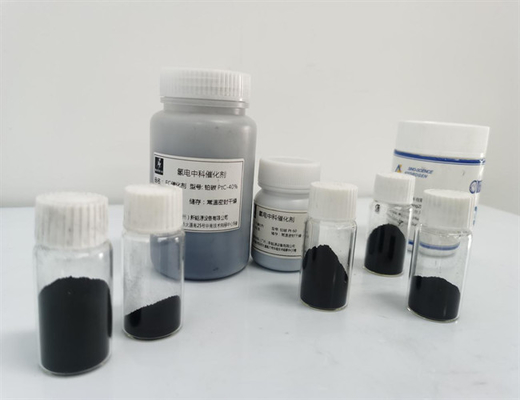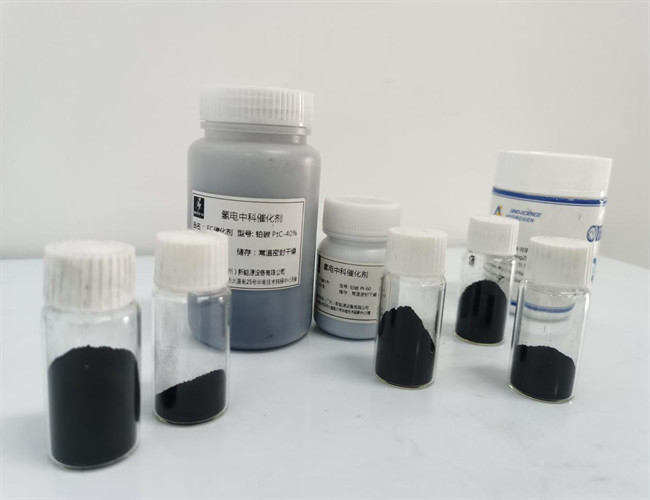40 Platinum On Carbon Catalyst , Chloroplatinic Acid Fuel Cell Platinum Catalyst
Product Details:
| Place of Origin: | Created in China |
| Brand Name: | Sino-Science Hydrogen |
| Certification: | ISO9001, ISO14001 quality management system certification |
| Model Number: | 40% loading |
Payment & Shipping Terms:
| Minimum Order Quantity: | 5g |
|---|---|
| Price: | Negotiable |
| Packaging Details: | Professional packaging |
| Delivery Time: | Within one month after order |
| Payment Terms: | T/T, MoneyGram |
| Supply Ability: | 50KG/months |
|
Detail Information |
|||
| Color: | Black | Material: | Chloroplatinic Acid |
|---|---|---|---|
| Purpose: | Power Generation | Morphology: | Powder |
| Specifications: | Pt/C | PtLoading: | 20~60 |
| High Light: | 40 Platinum On Carbon Catalyst,Chloroplatinic Acid Platinum On Carbon Catalyst,40 fuel cell platinum catalyst |
||
Product Description
Catalyst Powder Platinum On Carbon Catalyst Black
Specification
| Color | Black |
| Material | Chloroplatinic acid |
| Purpose | Power Generation |
| Oxygen reduction mass activity (Amg-1Pt@0.9VRHE) | 0.18-0.22 |
| Moisture content (wt.%) | 2-10 |
| Cas | 7440-06-4 |
| XRD particle size (nm) | 1.2-3.0 |
Description
Platinum has proven to be the standard catalyst for many oxidation and reduction reactions in both acidic and basic electrolytes and would be an ideal candidate for process feasibility studies. We call this next generation catalyst "HP" for High Power catalysts. Typically, as the platinum loading on a carbon support increases, the platinum particles grow in size, especially at the higher loadings, ultimately reducing the available active surface area of the platinum. However, this new platinum catalyst resists this trend, and is evident under the Technical Information section below, the new series maintains a small platinum crystallite size even at the high metal loadings. Amazingly, at these higher loadings we are able to maintain relatively high platinum surface areas, thus only moderately reducing the available active surface area of the platinum. For this new catalyst series the tap density continues to more closely resemble that of the uncatalyzed carbon. Tap density is often used as a general indicator of the quality of electrode formation, whereby the greater carbon character foretells of a well dispersed electrode layer.
Platinum is most commonly used for Polymer Electrolyte Fuel Cell (PEMFC), Direct Methanol Fuel Cell (DMFC), Microbial Fuel Cell (MFC), and Phosphoric Acid Fuel Cell (PAFC) applications as the cathode catalyst or anode catalyst. It is also used as a recombination catalyst for hydrogen elimination. Platinum on Vulcan can also be used as a building block for sensor elements.
Platinum on carbon is used for catalytic hydrogenations in organic synthesis. Examples include carbonyl reduction, nitro compound reduction, secondary amine production via nitrile reduction, and the production of saturated heterocycles from their respective aromatic compound precursors.
Synthesis of catalysts Pt/C by electroless deposition method
Vulcan XC-72 carbon with particle size ∼40 nm serving as support was purchased from Fuel Cell Earth Co. (USA). All the chemicals were of analytical grade. Chloroplatinic acid hexahydrate (H2PtCl6·6H2O), sodium borohydride (NaBH4), ethylene glycol (EG), potassium hydroxide (KOH), hydrochloric acid (HCl) (all from Merck) were used.
Pt/C catalysts particles were synthesized by the following route: at first Vulcan XC-72 carbon supports were pre-treated by heating at 773 K for 2 h. Afterward, the carbon supports were filled, washed with a huge amount of deionized (DI) water, and then dried for one hour at 337 K. In the next stage, the carbon supports were dispersed into the solvent (DI water with and without EG). The precursor H2PtCl6·6H2O in concentration 10 g l−1 was poured with an amount calculated to get the content of Pt to be 20 wt% on the supports. After mixing, the mixture was ultrasonicated for 1 h. An excess amount of reduction agent NaBH4 0.01 M was added and then this mixture was heated to 80 °C at 4 h. Finally, the synthesized catalyst particles Pt/C were filled, washed by DI water, and dried for 12 h at 120 °C.
![]()



